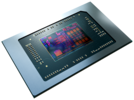AMD Ryzen 3 7335U vs AMD Ryzen Z1 Extreme vs AMD Ryzen 7 7736U
AMD Ryzen 3 7335U
► remove from comparison
The AMD Ryzen 3 7335U is a processor for mid-sized laptops based of the Rembrandt refresh generation. The Ryzen packs four of the eight cores based on the Zen 3+ microarchitecture. They are clocked at 3 (guaranteed base clock) to 4.3 GHz (single core boost) and support SMT / Hyperthreading (8 threads). The 7335U is the first Ryzen 3 based on the Zen 3+ architecture and slowest model of the 7035U series.
The Zen 3+ is a refresh of the Zen 3 architecture and should not offer a lot of changes. The chip offers modern features, like support for USB 4 (40 Gbps), PCI-E Gen 4 and DDR5-4800MT/s or LPDDR5-6400MT/s.
The performance should be clearly better than the old Ryzen 3 5300U and Ryzen 3 5425U due to the higher clock speed and improved architecture.
The integrated GPU Radeon 660M is still a fast iGPUs based on the RDNA2 architecture and offers 4 of the 12 CUs at up to 1.8 GHz.
The Ryzen 7335U is manufactured in 6nm FinFET at TSMC and specified at a TDP of 28W.
AMD Ryzen Z1 Extreme
► remove from comparison
The AMD Ryzen Z1 Extreme is a fast high-end laptop processor of the Phoenix series and fastest model of the U-series. It offers 8 cores (octa core) based on the Zen 4 architecture that supports SMT (hyperthreading , 16 threads). The cores clock from 3.3 (base) up to 5.1 GHz (single core boost). The processor includes 8 MB L2 cache and 16 MB L3 cache.
The performance of the R7 7840U is, depending on the workload, only slightly below the Ryzen 7 7840HS (higher base clock speed and TDP). Compared to the previous generation Ryzen 7 PRO 6850U, the 7840U is clearly faster thanks to the Zen 4 architecture and higher clock speeds. Compared to the similar Ryzen 7 7840U, the Z1 Extreme offers no AI engine.
The chip integrates a modern and fasts RDNA 3 graphics card (iGPU) called Radeon 780M with 12 CUs and up to 2.7 GHz clock speed. Furthermore, the Phoenix series include a video engine with AV1 de- and encoding, a new Xilinx FPGA based XDNA AI accelerator (Ryzen AI) that should be faster than the AI engine in the Apple M2 SOC and a dual-channel DDR5-5600 / LPDDR5x-7500 memory controller (with ECC support). The connectivity features includes 2 possible USB 4 (40 Gbps) ports and 20 PCIe 4.0 lanes for a GPU and SSDs.
The Phoenix series uses a single monolithic design (unlike the chiplet design of the 7045HX series) and is manufactured in the modern 4nm process at TSMC. The TDP can be configured between 15 and 30 Watt.
AMD Ryzen 7 7736U
► remove from comparison
The AMD Ryzen 7 7736U is a processor for mid-sized laptops based of the Rembrandt refresh generation. The R7 7736U integrates all eight cores based on the Zen 3+ microarchitecture. They are clocked at 2.7 (guaranteed base clock) to 4.75 GHz (Turbo) and support SMT / Hyperthreading (16 threads). The chip is manufactured on the modern 6 nm TSMC process. Compared to the previous Ryzen 7 6800U, the 7736U offers the same specs and a slightly higher possible TDP of 15-28W (vs 15-25W). The 7736U is a special version for HP of the Ryzen 7 7735U / Ryzen 7 6800U.
The Zen 3+ is a refresh of the Zen 3 architecture and should not offer a lot of changes. The chip offers modern features, like support for USB 4 (40 Gbps), PCI-E Gen 4 and DDR5-4800MT/s or LPDDR5-6400MT/s.
The performance should be similar to the old Ryzen 7 6800U due to the same specifications. The Ryzen 7 R7 7735U should be in theory a bit higher due to the 50 MHz higher boost clock.
The integrated GPU Radeon 680M is still one of the fastest iGPUs (only bested by the new Radeon 780M). It is based on the RDNA2 architecture and offers 12 CUs at up to 2.2 GHz.
The Ryzen 7736U is manufactured in 6nm FinFET at TSMC.
| Model | AMD Ryzen 3 7335U | AMD Ryzen Z1 Extreme | AMD Ryzen 7 7736U | ||||||||||||||||||||||||||||||||||||||||||||||||
| Codename | Rembrandt R | Phoenix (Zen 4) | Rembrandt R | ||||||||||||||||||||||||||||||||||||||||||||||||
| Series | AMD Rembrandt (Zen 3+) | AMD Phoenix (Zen 4) | AMD Rembrandt (Zen 3+) | ||||||||||||||||||||||||||||||||||||||||||||||||
| Series: Rembrandt (Zen 3+) Rembrandt R |
|
|
| ||||||||||||||||||||||||||||||||||||||||||||||||
| Clock | 3000 - 4300 MHz | 3300 - 5100 MHz | 2700 - 4700 MHz | ||||||||||||||||||||||||||||||||||||||||||||||||
| L1 Cache | 256 KB | 512 KB | 512 KB | ||||||||||||||||||||||||||||||||||||||||||||||||
| L2 Cache | 2 MB | 8 MB | 4 MB | ||||||||||||||||||||||||||||||||||||||||||||||||
| L3 Cache | 8 MB | 16 MB | 16 MB | ||||||||||||||||||||||||||||||||||||||||||||||||
| Cores / Threads | 4 / 8 AMD Zen 3+ | 8 / 16 | 8 / 16 | ||||||||||||||||||||||||||||||||||||||||||||||||
| TDP | 28 Watt | 30 Watt | 28 Watt | ||||||||||||||||||||||||||||||||||||||||||||||||
| Technology | 6 nm | 4 nm | 6 nm | ||||||||||||||||||||||||||||||||||||||||||||||||
| Die Size | 210 mm2 | 178 mm2 | |||||||||||||||||||||||||||||||||||||||||||||||||
| max. Temp. | 95 °C | 95 °C | |||||||||||||||||||||||||||||||||||||||||||||||||
| Socket | FP7 | FP7 | |||||||||||||||||||||||||||||||||||||||||||||||||
| Features | XFR, FMA3, SSE 4.2, AVX2, SMT | XFR, FMA3, SSE 4.2, AVX2, SMT | |||||||||||||||||||||||||||||||||||||||||||||||||
| iGPU | AMD Radeon 660M ( - 1800 MHz) | AMD Radeon 780M ( - 2700 MHz) | AMD Radeon 680M ( - 2200 MHz) | ||||||||||||||||||||||||||||||||||||||||||||||||
| Architecture | x86 | x86 | x86 | ||||||||||||||||||||||||||||||||||||||||||||||||
| Announced | |||||||||||||||||||||||||||||||||||||||||||||||||||
| Manufacturer | www.amd.com | www.amd.com | www.amd.com |
Benchmarks
Average Benchmarks AMD Ryzen Z1 Extreme → 0% n=0
Average Benchmarks AMD Ryzen 7 7736U → 0% n=0
* Smaller numbers mean a higher performance
1 This benchmark is not used for the average calculation












